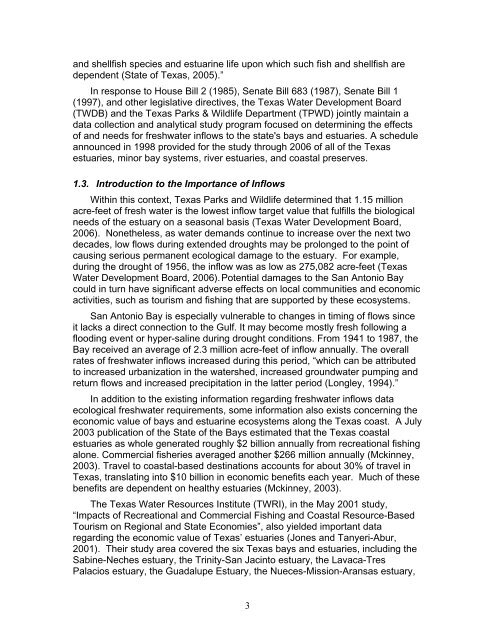The Economic Value of Water and Ecosystem Preservation
The Economic Value of Water and Ecosystem Preservation
The Economic Value of Water and Ecosystem Preservation
Create successful ePaper yourself
Turn your PDF publications into a flip-book with our unique Google optimized e-Paper software.
<strong>and</strong> shellfish species <strong>and</strong> estuarine life upon which such fish <strong>and</strong> shellfish are<br />
dependent (State <strong>of</strong> Texas, 2005).”<br />
In response to House Bill 2 (1985), Senate Bill 683 (1987), Senate Bill 1<br />
(1997), <strong>and</strong> other legislative directives, the Texas <strong>Water</strong> Development Board<br />
(TWDB) <strong>and</strong> the Texas Parks & Wildlife Department (TPWD) jointly maintain a<br />
data collection <strong>and</strong> analytical study program focused on determining the effects<br />
<strong>of</strong> <strong>and</strong> needs for freshwater inflows to the state's bays <strong>and</strong> estuaries. A schedule<br />
announced in 1998 provided for the study through 2006 <strong>of</strong> all <strong>of</strong> the Texas<br />
estuaries, minor bay systems, river estuaries, <strong>and</strong> coastal preserves.<br />
1.3. Introduction to the Importance <strong>of</strong> Inflows<br />
Within this context, Texas Parks <strong>and</strong> Wildlife determined that 1.15 million<br />
acre-feet <strong>of</strong> fresh water is the lowest inflow target value that fulfills the biological<br />
needs <strong>of</strong> the estuary on a seasonal basis (Texas <strong>Water</strong> Development Board,<br />
2006). Nonetheless, as water dem<strong>and</strong>s continue to increase over the next two<br />
decades, low flows during extended droughts may be prolonged to the point <strong>of</strong><br />
causing serious permanent ecological damage to the estuary. For example,<br />
during the drought <strong>of</strong> 1956, the inflow was as low as 275,082 acre-feet (Texas<br />
<strong>Water</strong> Development Board, 2006). Potential damages to the San Antonio Bay<br />
could in turn have significant adverse effects on local communities <strong>and</strong> economic<br />
activities, such as tourism <strong>and</strong> fishing that are supported by these ecosystems.<br />
San Antonio Bay is especially vulnerable to changes in timing <strong>of</strong> flows since<br />
it lacks a direct connection to the Gulf. It may become mostly fresh following a<br />
flooding event or hyper-saline during drought conditions. From 1941 to 1987, the<br />
Bay received an average <strong>of</strong> 2.3 million acre-feet <strong>of</strong> inflow annually. <strong>The</strong> overall<br />
rates <strong>of</strong> freshwater inflows increased during this period, “which can be attributed<br />
to increased urbanization in the watershed, increased groundwater pumping <strong>and</strong><br />
return flows <strong>and</strong> increased precipitation in the latter period (Longley, 1994).”<br />
In addition to the existing information regarding freshwater inflows data<br />
ecological freshwater requirements, some information also exists concerning the<br />
economic value <strong>of</strong> bays <strong>and</strong> estuarine ecosystems along the Texas coast. A July<br />
2003 publication <strong>of</strong> the State <strong>of</strong> the Bays estimated that the Texas coastal<br />
estuaries as whole generated roughly $2 billion annually from recreational fishing<br />
alone. Commercial fisheries averaged another $266 million annually (Mckinney,<br />
2003). Travel to coastal-based destinations accounts for about 30% <strong>of</strong> travel in<br />
Texas, translating into $10 billion in economic benefits each year. Much <strong>of</strong> these<br />
benefits are dependent on healthy estuaries (Mckinney, 2003).<br />
<strong>The</strong> Texas <strong>Water</strong> Resources Institute (TWRI), in the May 2001 study,<br />
“Impacts <strong>of</strong> Recreational <strong>and</strong> Commercial Fishing <strong>and</strong> Coastal Resource-Based<br />
Tourism on Regional <strong>and</strong> State Economies”, also yielded important data<br />
regarding the economic value <strong>of</strong> Texas’ estuaries (Jones <strong>and</strong> Tanyeri-Abur,<br />
2001). <strong>The</strong>ir study area covered the six Texas bays <strong>and</strong> estuaries, including the<br />
Sabine-Neches estuary, the Trinity-San Jacinto estuary, the Lavaca-Tres<br />
Palacios estuary, the Guadalupe Estuary, the Nueces-Mission-Aransas estuary,<br />
3
















